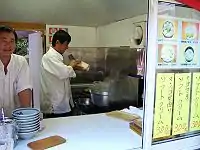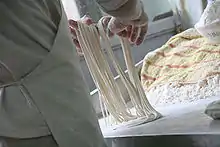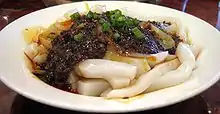Chinese noodles
Noodles are an essential ingredient and staple in Chinese cuisine. Chinese noodles vary widely according to the region of production, ingredients, shape or width, and manner of preparation. They are an important part of most regional cuisines within China, and other countries with sizable overseas Chinese populations.
 | |
| Type | Noodles |
|---|---|
| Place of origin | China |
Chinese-style noodles have also entered the cuisines of neighboring East Asian countries such as Korea (jajangmyeon) and Japan (ramen), as well as Southeast Asian countries such as Vietnam, Cambodia (kuy teav), Thailand and The Philippines.
Nomenclature
Nomenclature of Chinese noodles can be difficult due to the vast spectrum available in China and the many dialects of Chinese used to name them. In Mandarin, miàn (simplified Chinese: 面; traditional Chinese: 麵; often transliterated as "mien" or "mein" ) refers to noodles made from wheat flour, while fěn (粉) or "fun" refers to noodles made from other starches, particularly rice flour and mung bean starch. Each noodle type can be rendered in pinyin for Mandarin, but in Hong Kong and neighboring Guangdong it will be known by its Cantonese pronunciation ("meen" or "mien" for wheat noodles, "fun" for non-wheat). Taiwan, Malaysia, Singapore and many other Overseas Chinese communities in Southeast Asia may use Hokkien (Min Nan) instead (e.g. "mee" for wheat noodles).
History
The earliest written record of noodles is from a book dated to the Eastern Han period (25–220 CE).[1] Noodles, often made from wheat dough, became a prominent staple of food during the Han dynasty.[2] In the Western Han Dynasty, due to the demand for military, it was necessary for the Government to implement food processing technologies that would make the food storage easier and more affordable. During this time, “Laomian” emerged, it was made with starch rich buckwheat, millet and pea flours with lower water content, making it easier to store and transport.[3]
During the Song dynasty (960–1279) noodle shops were very popular in the cities, and remained open all night. During the earlier dynastic periods Chinese wheat noodles were known as "soup cake" (Chinese: 湯餅; pinyin: tāng bǐng), as explained by the Song dynasty scholar Huáng Cháo Yīng (黃朝英) mentions in his work "A delightful mixed discussion on various scholarly topics" (Chinese: 靖康緗素雜記; pinyin: jìngkāngxiāngsùzájì, Scroll 2) that in ancient times bready foods like pasta are referred collectively as "bing" and differentiated through their cooking methods.[4]·
Production
Chinese noodles are generally made from either wheat flour, rice flour, or mung bean starch, with wheat noodles being more commonly produced and consumed in northern China and rice noodles being more typical of southern China. Egg, lye, and cereal may also be added to noodles made from wheat flour in order to give the noodles a different color or flavor. Egg whites, arrowroot or tapioca starch are sometimes added to the flour mixture in low quantities to change the texture and tenderness of the noodles' strands. Although illegal, the practice of adding the chemical cross-linker borax to whiten noodles and improve their texture is also quite common in East Asia.[5] In general, the chinese noodles cooking method involves making a dough with flour, salt, and water; mixing the dough by hand to form bar shapes; bending the bars for proofing; pulling the bars into strips; dropping the strips into a pot with boiling water; and removing the noodles when finished cooking.[6] Chinese type noodles are generally made from hard wheat flours, characterized by bright creamy white or bright yellow color and firm texture. [7]
Before the automatic noodle machine was invented in 1950s, the processing of Chinese noodles were made with four steps, including:
- Fresh - The noodles are often consumed within 24 hours of manufacture due to quick discoloration. Their shelf life can be extended to 3-5 days if stored under refrigeration;
- Dried - Fresh noodle strands are dried by sunlight or in a controlled chamber;
- Boiled - Fresh noodle strands are either parboiled or fully cooked. After parboiling, Chinese noodles are rinsed in cold water, drained and covered with 1-2% vegetable oil to prevent sticking;
- Steamed - Fresh alkaline noodle strands are steamed in a steamer and softened with water through rinsing.[8]
The dough for noodles made from wheat flour is typically made from wheat flour, salt, and water, with the addition of eggs or lye depending on the desired texture and taste of the noodles. Rice- or other starch-based noodles are typically made with only the starch or rice flour and water. After the formation of a pliable dough mass, one of five types of mechanical processing may be applied to produce the noodles:
| English | Chinese | Pinyin | Process |
|---|---|---|---|
| Cut | 切 | qiē | The dough is rolled out into a flat sheet, folded, and then cut into noodles of a desired width |
| Extruded | 挤压 | jǐ yā | The dough is placed into a mechanical press with holes through which the dough is forced to form strands of noodles |
| Peeled | 削 | xiāo | A firm dough is mixed and formed into a long loaf. Strips of dough are then quickly sliced or peeled off the loaf directly into boiling water[9] |
| Pulled | 拉 | lā | The dough is rolled into a long cylinder, which is then repeatedly stretched and folded to produce a single thin strand[10] |
| Kneaded | 揉 | róu | A ball of dough is lightly rolled on a flat surface or kneaded with one's hands until it is formed into the desired shape[11] |
| Flicked | 柭 | bó | A soft dough is prepared, placed in a bowl, strips of dough are pulled and flicked directly into boiling water using a flexible bamboo stick or chopstick[12] |
While cut and extruded noodles can be dried to create a shelf-stable product to be eaten months after production, most peeled, pulled and kneaded noodles are consumed shortly after they are produced.
 Peeling thin strips of dough from a loaf directly into a container of boiling water to make daoxiaomian (刀削面)
Peeling thin strips of dough from a loaf directly into a container of boiling water to make daoxiaomian (刀削面) Pulling wheat dough into one thin strand to form lamian
Pulling wheat dough into one thin strand to form lamian
Cooking

Noodles may be cooked from either their fresh (moist) or dry forms. They are generally boiled, although they may also be deep-fried in oil until crispy. Boiled noodles may then be stir fried, served with sauce or other accompaniments, or served in soup, often with meat and other ingredients. Certain rice-noodles are made directly from steaming the raw rice slurry and are only consumed fresh.
Unlike many Western noodles and pastas, Chinese noodles made from wheat flour are usually made from salted dough, and therefore do not require the addition of salt to the liquid in which they are boiled. Chinese noodles also cook very quickly, generally requiring less than 5 minutes to become al dente and some taking less than a minute to finish cooking, with thinner noodles requiring less time to cook. Chinese noodles made from rice or mung bean starch do not generally contain salt.
Types
Wheat
These noodles are made only with wheat flour and water. If the intended product is dried noodles, salt is almost always added to the recipe.
| Common English name | Characters | Pinyin | Cantonese | Hokkien | Description |
|---|---|---|---|---|---|
| Cat's ear | 貓耳朵 | māo ěr duǒ | maau ji do | ? | Looks like a cat's ear; similar to western Orecchiette |
| Cold noodles | 凉面
涼麵 |
liáng miàn | loeng mein | ? | Served cold |
| Dao xiao mian | 刀削面
刀削麵 |
dāo xiāo miàn | doe soek mein | ? | Relatively short flat noodle peeled by knife from a firm slab of dough |
| Lamian | 拉麵 | lā miàn | laai min | la-mī | Hand-pulled noodles from which ramen was derived |
| Yaka mein (Yat ca mein, Yet ca mein) | 一個麵 一家麵 |
yī gè miàn | ? | ? | North American Chinese style wheat noodles similar to spaghetti; sold in Canada and the United States |
| Lo mein | 捞面
撈麵 |
lāo miàn | lo mein | lo mi | Egg noodles that are stir fried with sliced vegetables and/or meats and other seasonings |
| Misua | 面线
麵線 |
miàn xiàn | mein sin | mī-sòaⁿ | Thin, salted wheat noodles (1 mm diameter). Can be caramelized to a brown colour through extensive steaming. Similar to very fine vermicelli |
| 宮麵 | gōng miàn | ? | ? | ||
| Saang mein | 生面
生麵 |
shēng miàn | saang min | senn mī | Soapy texture |
| Thick noodles | 粗面
粗麵 |
cū miàn | cou min | chho͘-mī | Thick wheat flour noodles, from which udon was derived |
Lye-water or egg
These wheat flour noodles are more chewy in texture and yellow in colour either due to the addition of lye (sodium carbonate, potassium carbonate, calcium hydroxide, or potassium hydroxide) and/or egg. This class of lye water noodles (Chinese: 碱面/碱麵; pinyin: jiǎn miàn) has a subtle but distinctive smell and taste, described by some as being "eggy".[13]
| Common English name | Characters | Pinyin | Cantonese | Hokkien | Description |
|---|---|---|---|---|---|
| Oil noodles | 油面
油麵 |
yóu miàn | jau min | iû-mī | Made of wheat flour and egg or lye-water; often comes pre-cooked. |
| Thin noodles | 幼面
幼麵 |
yòu miàn | jau min | iù-mī | Thin lye-water noodles; one of the most common Cantonese noodles |
| Mee pok | 麵薄 | miàn báo | ? | mī-po̍k | Flat egg or lye-water noodles. Similar to tagliatelle |
| Yi mein | 伊麵 伊府麵 | yī miàn yī fǔ miàn | yī mihn
yī fú mihn |
i-mī
i-hú-mī |
Fried, chewy noodles made from wheat flour and egg or lye-water |
| Shrimp roe noodles | 蝦子麵 | xiā zǐ miàn | haa zi min | hê-tsí-mī | Made of wheat flour, lye-water, and roe, which show up as black spots |
| Jook-sing noodles | 竹昇麵 | zhú shēng miàn | zuk sing min | tik-sing-mī | A rare type of Cantonese noodle in which the dough is tenderized with a large bamboo log |
Rice
Rice-based noodles can be:
- Extruded from a paste and steamed into strands of noodles
- Steamed from a slurry into sheets and then sliced into strands
These noodles are typically made only with rice and water without the addition of salt. Although unorthodox, some producers may choose to add other plant starches to modify the texture of the noodles.
| Common English name | Characters | Pinyin | Cantonese | Hokkien | Description |
|---|---|---|---|---|---|
| Kway teow | 粿条 | gǔo tiáo | gwó tìuh | kóe-tiâu | Flat rice noodles |
| Ho fun, Chow fun | 沙河粉 | shā hé fěn | saa ho fan | sa-hô-hún | Very wide, flat, rice noodles |
| 河粉 | hé fěn | ho fan | hô-hún | ||
| Lai fun | 瀨粉 酹粉 | lài fěn | laai fan | luā-hún | Thick round semi-transparent noodle made from sticky rice |
| Mai sin | 米線 米线 | mǐ xiàn | mai sin | bee sua | Rice noodles also called Guilin mífěn (桂林米粉) |
| Rice vermicelli | 米粉 | mí fěn | mai fen | bí-hún | Thin rice noodles |
Starch

These noodles are made using various plant starches. Mung bean starch noodles will often be cut with tapioca starch to make them more chewy and reduce production costs.
| Common English name | Characters | Pinyin | Cantonese | Hokkien | Description |
|---|---|---|---|---|---|
| Winter noodles | 冬粉 | dōng fěn | dung1 fan2 | tang-hún | Very thin mung bean starch noodles, similar to vermicelli |
| Bean threads | 粉絲 | fěn sī | fan2 si1 | ? | Thin cellophane-like noodles |
| Mung bean sheets | 粉皮 | fěn pí | fan2 pei4 | hún-phê | Wide, clear noodles made from mung bean starch |
| Liang pi | 凉皮 | líang pí | loeng4 pei4 | ? | Translucent noodles made from wheat starch left from producing gluten |
| Silver needle noodles | 銀針粉 | yín zhēn fěn | ngan4 dzam1 fan2 | ? | Spindle-shaped wheat starch noodles, ca. 5 cm in length and 3–5 mm in diameter |
| 老鼠粉 | lǎo shǔ fěn | lou5 sy2 fan2 | niáu-chhú-hún | ||
| Suān là fěn | 酸辣粉 | suān là fěn | syn1 laat6 fan2 | ? | Chongqing hot & spicy sweet potato starch noodles |
Oat

In China, particularly in western Inner Mongolia and Shanxi province, oat (Avena nuda) flour is called yóu miàn (莜面), and is processed into noodles or thin-walled rolls, which are consumed as staple food.[14] The process of making oat noodles is special. The oat dough is twisted on marble plate which can ensure the dough will not stick on it, into strips and thin-rolls. It can be boiled and also steamed with different sauces to eat.[15]
Chinese noodle dishes
The following are a small portion of Chinese dishes that incorporate noodles:
See also
References
- Roach, John (12 October 2005). "4,000-Year-Old Noodles Found in China". National Geographic. Retrieved 12 October 2011.
- Sinclair, Thomas R.; Sinclair, Carol Janas (2010). Bread, beer and the seeds of change : agriculture's imprint on world history. Wallingford: CABI. p. 91. ISBN 978-1-84593-704-1.
- "AACCI Grain Science Library". doi:10.1094/cfw-62-2-0044. Cite journal requires
|journal=(help) - 黃, 朝英, 靖康緗素雜記 (in Chinese), 2
- 使用硼砂替代品吃得更安心, 彰化縣衛生局 (Changhua county health bureau), 4 September 2008, archived from the original on 29 July 2013
- "AACCI Grain Science Library". doi:10.1094/cfw-62-2-0044. Cite journal requires
|journal=(help) - Ranhotra, Gur (1998). "ASIAN NOODLE TECHNOLOGY" (PDF). Asian Noodle. Volume XX, Issue 12: 1.
- Ranhotra, Gur (1998). "ASIAN NOODLE TECHNOLOGY" (PDF). Asian Noodle. Volume XX, Issue 12: 2.
- 中国美食探秘 (Secrets of Chinese Cuisine), 中国中央电视台 (CCTV), 7 November 2014
- 中国美食探秘 (Secrets of Chinese Cuisine), 中国中央电视台 (CCTV), 7 November 2014
- 中国美食探秘 (Secrets of Chinese Cuisine), 中国中央电视台 (CCTV), 7 November 2014
- 中国美食探秘 (Secrets of Chinese Cuisine), 中国中央电视台 (CCTV), 7 November 2014
- McGEE, HAROLD (14 September 2010), For Old-Fashioned Flavor, Bake the Baking Soda, The New York Times Company
- "Braised potato and oat noodles". China Daily. Archived from the original on 27 June 2018. Retrieved 16 October 2017.
- "[Eat it]: Shanxi Oat Noodles". smartshanghai. Retrieved 16 October 2017.